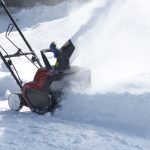An edger helps to create the borders that will define your lawn and garden, and help to keep those borders under control when plants start getting a bit out of hand. Unfortunately, a nice, crisp border requires quite a bit of upkeep or else it gets sloppy, and a sloppy border is just as unattractive as having no border at all. So what type of edger will be your best bet to create or maintain the borders around your lawn?
Trimmer
A standard weed-whacker or lawn trimmer can be used for creating and maintaining borders, but it will leave a bit of a ragged edge. It is dangerous to use in a vertical position, as the guard is not set up to protect for this kind of usage. Finally, the string or wire used in many trimmers is not made to cut away at sod and dirt, and will wear down quickly. A trimmer should only be used as an emergency edger for upkeep.
Stick Edger
Best suited for upkeep, and fairly poor at cutting in new edges, stick edgers are beginning to lose favor. They need to be carried like a trimmer, so they can cause the user to fatigue quickly on large jobs. They are a single-purpose tool, and often aren’t worth the investment, as trimmer, edger/trimmer combos and multi-use tools are often cheaper yet more useful.
Edger/Trimmer Combo
By combining the power of a trimmer with a flexible shaft that allows for the user to adjust the angle of the head, the edger/trimmer becomes a tool that is useful for many jobs, justifying the cost a bit better than a stick edger. These aren’t good for cutting a new edge, as almost all of them come with string or wire that cannot cut in to sod or ground deeply or cleanly.
Walk-Behind Wheeled Edger
These are powerful machines, meant to chew through sod and dirt, and are the best option for creating a new edge, whether you’re working along a sidewalk or creating a ring around a tree. They are heavy, but as they are wheeled, the user is less likely to get fatigued during use. Many walk-behind edgers can be fitted with trenching attachments for cutting in irrigation, while top-of-the-line models will have adjustable blades that can be angled to work as a mini-brushcutter. These are workhorses, and are great for commercial usage and large lawns. If you’ve got a small lawn, the good news is that these are often able to be rented from lawn equipment stores, so you won’t have to invest in a unit you may not use often.
Multi-Use Tools
Essentially stick edgers as far as operation goes, the main difference is that the tool unit can be switched out for multiple different attachments, while the power unit will stay the same. The attachments on offer include pole saw attachments, hedge trimmer attachments, and more. This is a particularly attractive way to go for the person who has limited storage space but needs multiple tools for upkeep.






